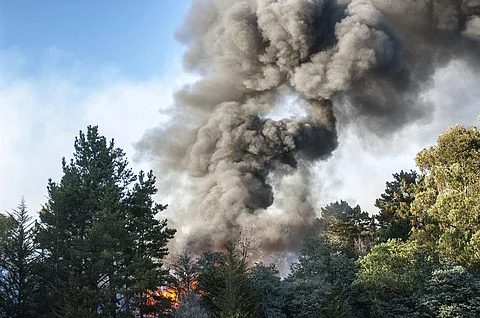

Exposure to air pollution caused by landscape fires, including blazes in forests, shrubs, grass, pastures and agricultural land, has increased over the last 10 years, according to a new study.
Similar to most climate crises, the consequences of such fires are unevenly distributed across the world. Many low- and middle-income countries face more severe fire-sourced air pollution than high-income countries that receive the most media and research attention, according to the study published in the journal Nature on September 20, 2023.
This disparity is mainly due to their locations. Many low- and middle-income countries are in hot and dry areas prone to landscape fires. Other factors are also responsible for widening the gap. For instance, less industrialised countries have more agricultural waste burning, deliberate burning of forests for agricultural or other purposes and poorer management or control of wildfires.
Globally, 2.18 billion people were exposed to at least one day of substantial landscape fire-sourced air pollution every year from 2010-2019, according to the document.
This equates to an average of 9.9 days of exposure per person annually, representing a 2.1 per cent increase in the last 10 years. Landscape fires refer to any burning in natural and cultural landscapes, including planned or controlled fires and wildfires.
The exposure levels were particularly high in several hotspots like Central Africa, Southeast Asia, South America and Siberia. The analysis also identified regional hotspots of high levels of fire-sourced air pollution in Australia, the United States and Canada.
Air pollution from landscape fires can negatively affect human health. However, the consequences of such fire-sourced air pollution have not been well characterised globally.
The research estimated global daily landscape fire-sourced outdoor fine particulate matter (PM2.5) and surface ozone (O3) concentrations for 2000-2019.
“We estimated the world’s first daily fire-sourced O3 data with global coverage,” said researchers.
They used a machine-learning approach with inputs from chemical transport models, ground-based monitoring stations and weather data.
Landscape fire-sourced air pollution increased significantly to 72.8 billion exposed person-days per year in 2010-2019 from 63.2 billion in 2000-2009, the study reported.
Evidence shows wildfires are increasingly frequent and severe due to climate change. For instance, the horrific 2019-2020 Australian bushfire, which burnt more than 46 million acres of land, was likely responsible for La Nina’s three-year streak.
Intense wildfires have also altered kilometres of atmosphere, widening the ozone hole, according to another research.
According to researchers, no study has looked at the long-range effect of increasing global landscape fires. Wildfires often impact remote areas with few or no air quality monitoring stations. In addition, many low-income countries have no air quality monitoring stations, even in urban areas.
Many low- and middle-income countries face more severe fire-sourced air pollution than high-income countries that receive most media and research attention.
More attention is needed for those neglected countries to mitigate their fire-sourced air pollution and the related health consequences, the study suggested.
Exposure to fire-sourced air pollution has many adverse health impacts, including increased mortality and morbidity and a global worsening of cardio-respiratory conditions and mental health.The study emphasised the urgent need for action to address this public health concern.
It recommended multisectoral efforts to reduce landscape fires and mitigate the adverse health effects. Strategies include evidence-based fire management, proper natural and urban landscape planning and design, and policy changes to limit agricultural waste burning and deliberate land conversion.